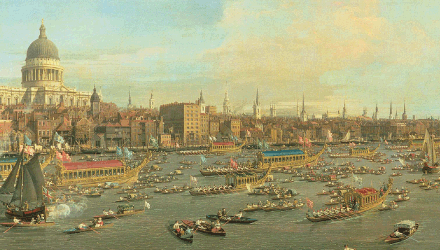
Though it is the epitome of a modern, cosmopolitan city today, London points out a crucial fact: Its ascent was neither easy nor inevitable. Historians Robert Bucholz and Joseph Ward provide a riveting account of a crucial period that witnessed the city’s rise to worldwide prominence, charting the critical factors that triggered the city’s transformation from a backwater city to the crown jewel of a global empire. We sat down with the authors for a chat about their book.
Why focus on 1550 to 1750?
We contend that this was the crucial period for London’s emergence as a city of world significance. Suburban Westminster was the seat of English national government throughout our period (and of the United Kingdom from the early eighteenth century), and London’s fate was largely tied to that of the nation as a whole. The people and interests attracted to the national power patronized a wide variety of London businesses and trades, including the fine and performed arts, as they drove the physical redevelopment of the emerging West End. At the same time, our period saw London maintain its position as the chief port in the realm, increasingly drawing into the metropolis goods and people from around the Atlantic World and beyond. The profits from this trade found their way into the hands of London’s merchants and, increasingly, bankers, interest groups who stood to benefit handsomely from the innovations of the late seventeenth century that are known collectively as the Financial Revolution. By bringing together the national leaders in government, business, and the arts, London in this period came to dominate the nation in ways that it had neither before nor since.
Plagues, fires, overcrowding, crime—living in London during this time sounded rough (unless perhaps one was part of the upper classes). What was city living like as the population swelled, and how did officials try to remedy these conditions?
Living conditions in early modern would strike residents of modern cities in developed nations as rough indeed. The acquisition of a basic necessity such as fresh water was for many something that could not be taken for granted, and the removal of waste—human as well as animal waste in addition to the byproducts of London’s many industrial enterprises—was a constant challenge to early modern city dwellers. These are principal reasons why the West End, which was both upriver and upwind from the rest of the metropolis, was the place where so many wealthy Londoners congregated.
That said, London’s population increased because it offered more economic opportunities and other attractions than did rural communities at the time. The government of the metropolis was arrayed in several overlapping jurisdictions, starting with more than one hundred parishes, each of which was the focal point for social life in a neighborhood. Parish officers along with those of City wards and suburban counties tried to stay abreast of, and respond to, the major social problems in their districts. Much of London’s social safety net consisted of private philanthropy, which much of London’s popular culture actively encouraged. So, the rich would lend a hand to the poor through the intervening authority of the city’s many hospitals or trade guilds. The social safety net was stretched to the breaking point many times during the period of our study—and especially during times of plague or general economic slowdowns—but remarkably it never broke.
How did coffee houses, taverns, theaters, pleasure gardens, and other establishments transform the city’s cultural scene?
As London grew throughout this period, it became an ever increasing marketplace for a wide variety of cultural pursuits. Throughout this time, taverns (which primarily offered wine), alehouses (for beer), and victualing houses (hot and cold food) were scattered across the metropolis and offered opportunities for companionship to newcomers as well as old London hands. From the middle of the seventeenth century, these were joined by coffee houses, which dispensed a rather exotic yet stimulating beverage along with opportunities to read about—and certainly to discuss—the latest news. During the late seventeenth and early eighteenth centuries, coffee houses became a central means for ordinary Londoners to become engaged with the public life of the metropolis and the nation. Indeed, coffee houses and newspapers grew in popularity together across the second half of our period. Together, they became the principal means for Londoners to stay on top of the major developments in political and commercial affairs, developments that could affect their livelihoods.
London also provided ample means for those seeking an escape from the stresses of city life. Even from before 1550, the south bank of the Thames was the site of several forms of entertainment, and to these were added the principal public theaters of the golden age of English drama from the final years of Elizabeth’s reign until they were closed at the outset of the Civil War.
Nowadays, London is a bustling cosmopolitan city that everyone believes they already know, whether through books or movies or other forms of popular culture. What do you think will surprise readers most about London’s ascent to prominence?
Perhaps most surprising will be the sheer number and variety of activities and attitudes that we associate with modern urban life and that had their first flowering in London during the period covered in our book. Coffee houses with the latest newspapers; literary and scientific societies with regular lectures; museums and theaters that were accessible to the general public; banks, stock exchanges, and insurance companies; these are just some of the institutions that make modern urban life worth all of the cost and bother. It may also surprise some readers that so many of the attributes that make London a world-class city—especially its combination of government, business, and the arts—as well as its basic physical layout were present by 1750.
Latest Comments
Have your say!